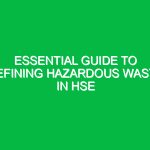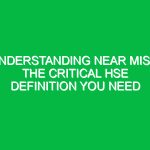Welcome to Our Toolbox Talk
Good morning, everyone! Thank you for gathering for today’s toolbox talk. As we prepare to start our workday, it’s crucial to focus on an often-overlooked aspect of our Safety protocols: Slip Hazards and Safety. Understanding how to identify, manage, and prevent slip Hazards can significantly reduce the risk of accidents and injuries on the job. Today, we’ll discuss practical tips, best practices, and real-life scenarios that will help keep us all safe.
Understanding Slip Hazards
First, let’s define what we mean by slip hazards. A slip hazard is any condition that increases the likelihood of slipping, which can lead to falls. These hazards can emerge from a variety of sources, such as:
- Wet surfaces: Spills, rain, or cleaning can create slippery conditions.
- Uneven flooring: Cracks, holes, or changes in elevation can catch our feet off guard.
- Obstacles: Tools, equipment, or debris left in walkways can pose serious risks.
- Improper footwear: Shoes that lack slip resistance can increase the chance of falling.
Recognizing these hazards is the first step towards ensuring a safer workplace.
The Importance of Addressing Slip Hazards
Why is it so important to focus on slip hazards and safety? Consider the statistics: slips, trips, and falls are among the leading causes of workplace injuries. According to the Occupational Safety and Health Administration (OSHA), these incidents account for a significant percentage of lost workdays. Not only can they lead to serious injuries, but they can also affect team morale and productivity. By prioritizing slip Hazard Prevention, we can foster a safer and more efficient work Environment.
Identifying Slip Hazards in the Workplace
Part of our responsibility as employees is to actively look for slip hazards in our surroundings. Here are some tips on how to identify potential risks:
- Conduct regular inspections: Take time to walk through work areas and identify any potential hazards.
- Communicate with your team: If you notice a hazard, report it immediately to a supervisor.
- Use signage and barriers: Clearly mark wet areas or hazardous zones to keep everyone informed.
Let’s make it a habit to keep our eyes open for these hazards, as Prevention starts with awareness.
Best Practices for Slip Hazard Prevention
Here are some practical steps we can take to minimize slip hazards:
- Keep work areas clean and organized: Clutter can obscure hazards. Ensure that walkways are clear of tools and materials.
- Promptly clean up spills: If something is spilled, clean it up right away to prevent slips. Use absorbent materials if necessary.
- Use appropriate footwear: Wear shoes that are designed for slip resistance. Check your footwear regularly to ensure it remains effective.
- Maintain proper lighting: Ensure that all work areas are well-lit, making it easier to spot hazards.
- Install non-slip mats: In areas prone to moisture, consider using mats designed to provide additional traction.
By adopting these practices, we can significantly reduce the likelihood of slips and falls in our workplace.
Real-Life Examples
Let’s take a moment to discuss a couple of real-life scenarios. In one instance, a worker slipped on a wet floor that had not been properly marked with warning signs. The resulting injury kept him out of work for weeks. In another case, a team member tripped over a tool left in the walkway, which led to a sprained ankle. Both incidents could have been prevented through better hazard identification and adherence to safety practices. These examples emphasize the importance of vigilance and proactive measures in preventing slip hazards.
Engaging in Safety Discussions
As we’ve discussed, slip hazards and safety are critical topics that require our attention. I encourage everyone to engage in discussions about safety practices. Here are some open-ended questions to consider:
- What common slip hazards have you encountered in our work environment?
- Can you share any strategies that have worked for you in preventing slips?
- How can we improve our current safety protocols regarding slip hazards?
Your feedback is invaluable and can help us create a more robust safety culture.
Regulations and Standards
Understanding the Regulations surrounding slip hazards and safety is vital for our compliance and safety efforts. osha has specific guidelines aimed at minimizing slip, trip, and fall incidents. These regulations outline the responsibilities of employers and employees to ensure a safe working environment. Familiarizing ourselves with these guidelines not only helps us stay compliant but also reinforces our commitment to safety.
Conclusion
In conclusion, the prevention of slip hazards is a shared responsibility that requires constant vigilance and commitment from all of us. Today, we’ve covered:
- The definition and importance of slip hazards.
- How to identify and address potential risks in our work environment.
- Best practices to prevent slips and falls.
- Real-life examples that highlight the consequences of neglecting slip hazards.
- Engagement in discussions about safety and compliance with regulations.
Thank you for your attention and for your commitment to safety. Let’s work together to ensure that we all go home safe at the end of the day. Remember, a safe workplace is a productive workplace!


